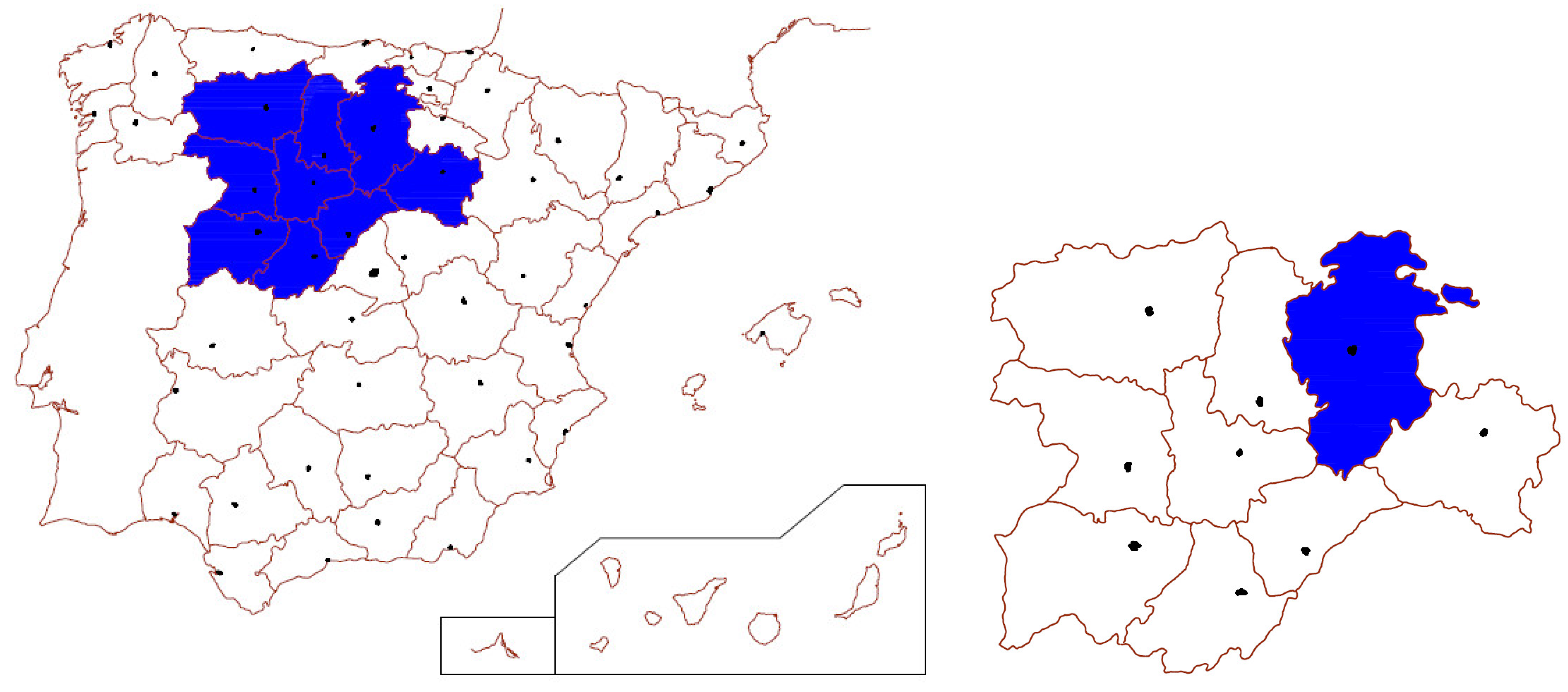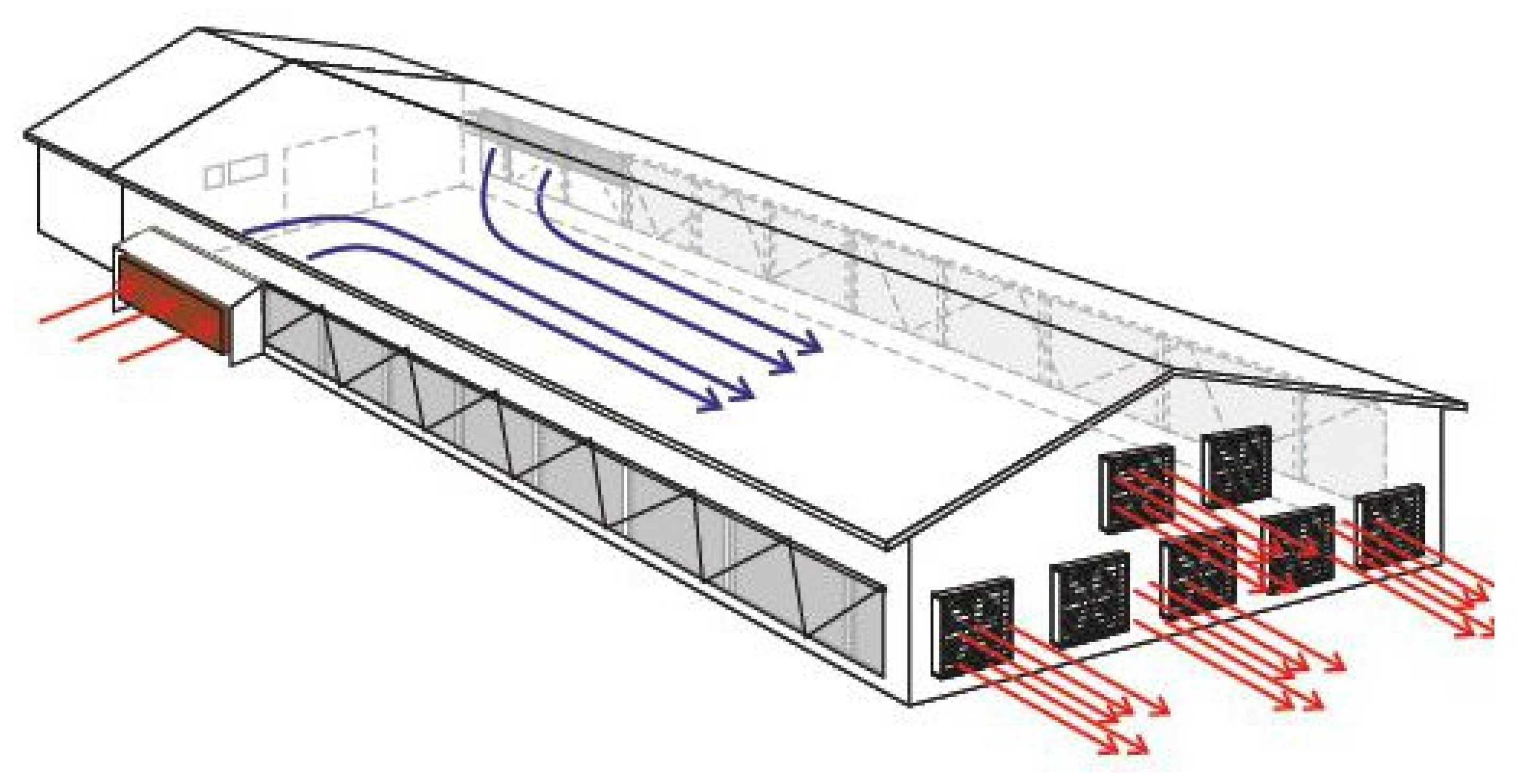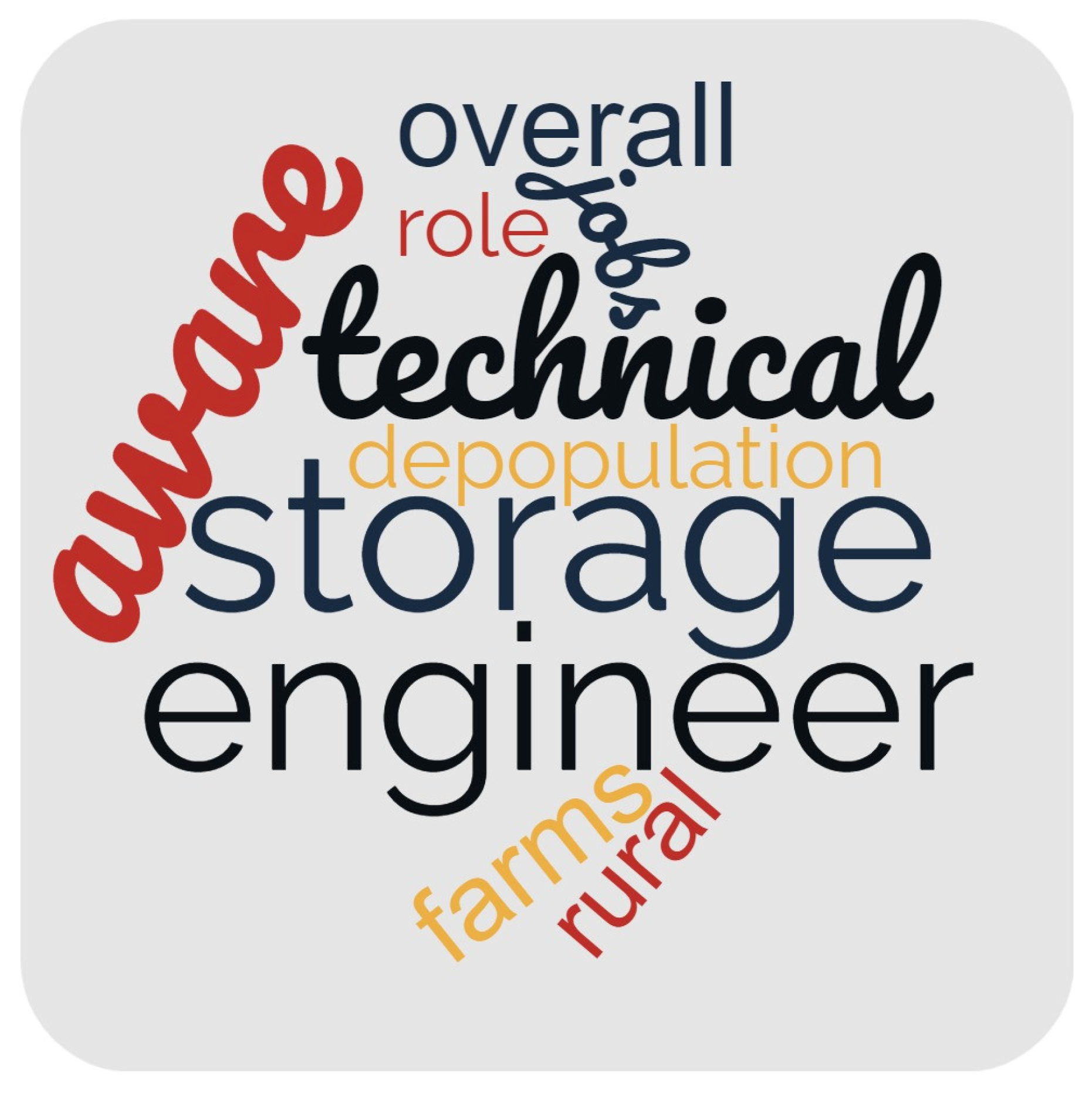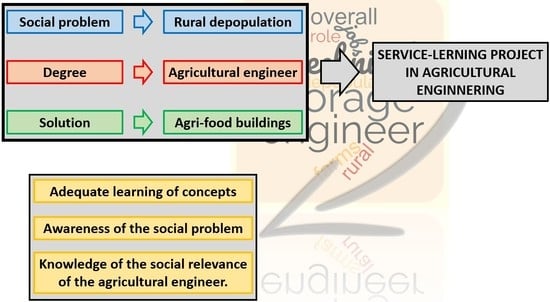Educating Future Agricultural Engineers at the University of Burgos, Spain, through a Service-Learning Project on Rural Depopulation and Its Social Consequences
Abstract
1. Introduction
2. Description of the Service-Learning Project
2.1. Social Problem Addressed: Rural Depopulation
2.2. Participants and Courses
2.3. Service-Learning Project Approach
2.3.1. Stages of the Project and Activities Conducted
- S1. Classroom presentation by the teachers of the important problem of rural depopulation, its possible causes, and its relevance for the sustainable development.
- S2. Sharing the main rural-development associations and identification of the most interesting areas for developing the actions with the students.
- S3. Classroom presentation of various proposals for the design of farms and agri-food buildings by the teachers.
- S4. Classroom debate involving students and teachers on the ideas collected during the previous stages, brainstorming, and exploring possible ways forward.
- S5. Development of agri-food building projects to address the social problem of rural depopulation (definition of the location, building type, and building design). Monitoring of the projects that the students developed by the teachers both in the classroom and in out-of-class tutorials.
- S6. Presentation, defense, and discussion of the proposals that were adopted and the designs that were developed.
- S7. Evaluation of the S-LP through a survey of open-ended questions whose questions and answers are presented in the following sections.
2.3.2. Reflection Activities
- R1. Reflection on the rural areas with which the students were familiar (their village, or places they have visited for various reasons). Description of the existing population (number, age, professions, etc.). Identification of the main sources of income of the people living in these rural areas (agriculture, livestock, industry, tourism, etc.).
- R2. Definition of the type of environments (culture, art, nature, leisure, work, etc.) the general population is seeking and how to implement them in rural areas.
- R3. Identification of possible improvements to existing economic activities within rural areas.
- R4. List of potential businesses that could promote depopulated areas.
- R5. Discussion of possible sources of financing or fiscal measures, so as to implement the agri-food buildings that the students were designing.
2.3.3. Service Outcomes
- Raising the visibility of depopulation within rural areas of the province of Burgos and the identification of areas for action.
- Awareness of the students with regard to the rural-depopulation problem, on which they can take an active position, as future agricultural engineers.
- Proposal of different measures for the creation and modernization of farms and agri-food industries in the identified areas of action that can improve the rural economy and thus the stability of the rural population.
2.3.4. Student Competencies
- Learning the necessary procedures for the design and the dimensioning of the areas within an agri-food building.
- Learning how to design the structural components of an agri-food building.
- Understanding the applicability of the design concepts covered in the course in professional practice.
- Design of a calculation report and plans for the design of an agri-food building.
- Public presentation and defense of the need for an action or a design.
- 6.
- Knowledge and contact with social entities and public administrations related to the project to be undertaken, obtaining the necessary information from them.
- 7.
- Identification of the information sources that form the basis of the need or problem to be addressed.
- 8.
- Development of autonomy in the search for information and ways to engage with a specific problem.
- 9.
- Internalization of the problem of rural depopulation and possible ways to address it, closely linked to the professional work of the agricultural engineer.
- 10.
- Understanding how the professional skills of an agricultural engineer can be applied to promote activities that can reduce depopulation based on their technical knowledge.
- 11.
- Learning how to identify social problems and to see the interface with their technical knowledge.
2.4. Final Student Delivery
2.4.1. Project 1
2.4.2. Project 2
3. Materials and Methods: Surveys to Assess the Service-Learning Project
3.1. Surveys Conducted
- Do you think that the agri-food buildings proposed by you and your classmates would really help to solve the problem of rural depopulation? What do you consider to be the main disadvantages for their success?
- What other approaches from the agricultural-engineering approach can you think of to stop rural depopulation? Explain in detail what it would consist of and how it would address depopulation within the rural environment.
- Were students involved with the S-LP, and what were their dynamics?
- Were they more or less motivated than they were with other activities on the course?
- Have the students learned the technical concepts of the course through the S-LP?
- Have students developed the personal skills set as a goal throughout the S-LP?
- What is your general assessment of the S-LP?
- What personal lessons did you take home from the S-LP experience?
3.2. Analysis of the Results
4. Results and Discussion
4.1. Student Survey
4.1.1. First Question: Utility of the Proposed Agri-Food Buildings
4.1.2. Second Question: Other Possible Measures to Solve Rural Depopulation
“[…] there are mountains that are full of weeds and extensive livestock farming is disappearing, which were responsible for clearing the mountains, so we could consider projects to clear up the mountains and improve rural roads, attract new population, generate jobs and improve the conditions of the rural environment […]”
4.2. Survey of Teachers
4.2.1. Evaluation of Students
“[…] this course has workshop practices, which is the aspect in which the students are usually the most interested […] the students showed a similar interest in the S-LP and in these practices […] I think that both teachers are very satisfied with our involvement in the S-LP proposal […]”
“In general, the students started out with adequate information that they themselves sought […] however, more initial support in the search for information would have been beneficial in some cases […] this would perhaps have helped to reduce the notable differences of level among the students between the geographical framing and the justification of the needs of the geographical area addressed in the project […]”
4.2.2. Personal Opinion
5. Conclusions
- The S-LP raised awareness of the social problem of rural depopulation and the proposals to address it, not only among students but also among teachers. It has therefore been confirmed that an S-LP is a teaching experience that, if properly conducted, can awaken a social commitment in all those involved.
- Participation in the S-LP fostered a critical spirit among the students, so that they not only looked for answers to the problem, but also sought the best way to solve it. In addition, all the activities performed led the students to reach a global vision of the social need. It meant that when proposing ways to address the issue of rural depopulation, they considered all its aspects and implications, so that the problem could be successfully addressed.
- Reflection on the social problem and the search for answers based on technical knowledge also helped the students to conceptualize a sense of social service as part of their profession as engineers. In this way, they realized that, as engineers, they could apply their technical knowledge to address existing social needs.
- The S-LP aroused student interest and motivation to learn the concepts addressed during the course. Motivation levels were similar to those found in the workshop practices, the part of the course preferred by the students, perhaps because of the usefulness of the concepts that were directly applied to a social issue.
- The students acquired the academic and personal competencies proposed as the objective of the S-LP from the teachers’ viewpoint. They therefore learned the technical concepts explained on the course and developed the capacity for autonomous work and searching for information, although in relation to this last aspect, it is important for the teacher to act as a guide in the first steps.
- Finally, the teachers themselves recognized that they had also learned throughout the S-LP, using this experience as a basis to propose new classroom dynamics and activities to favor active and socially committed learning. To that end, they recognized that it was necessary to rely on the university as a social entity that can make existing social problems visible and that can propose ways of engaging with these issues.
Author Contributions
Funding
Institutional Review Board Statement
Informed Consent Statement
Data Availability Statement
Acknowledgments
Conflicts of Interest
References
- Lim, J.; Ko, H.; Park, J.; Ihm, J. Effect of active learning and online discussions on the academic performances of dental students. BMC Med. Educ. 2022, 22, 312. [Google Scholar] [CrossRef] [PubMed]
- Cilliers, L.; Pylman, J. South African students’ perceptions of the flipped classroom: A case study of higher education. Innov. Educ. Teach. Int. 2022, 59, 296–305. [Google Scholar] [CrossRef]
- Del Río-Gamero, B.; Santiago, D.E.; Schallenberg-Rodríguez, J.; Melián-Martel, N. Does the Use of Videos in Flipped Classrooms in Engineering Labs Improve Student Performance? Educ. Sci. 2022, 12, 735. [Google Scholar] [CrossRef]
- Revilla-Cuesta, V.; Skaf, M.; Manso, J.M.; Ortega-López, V. Student perceptions of formative assessment and cooperative work on a technical engineering course. Sustainability 2020, 12, 4569. [Google Scholar] [CrossRef]
- Ruslan, M.S.H.; Sapiee, N.H.; Kurnia, K.A.; Amran, N.A.; Abd Rahman, N. Student Adoption and Effectiveness of Flipped Classroom Implementation for Process Simulation Class. Educ. Sci. 2022, 12, 763. [Google Scholar] [CrossRef]
- Hortigüela Alcalá, D.; Palacios Picos, A.; López Pastor, V. The impact of formative and shared or co-assessment on the acquisition of transversal competences in higher education. Assess. Eval. High. Educ. 2019, 44, 933–945. [Google Scholar] [CrossRef]
- Seifan, M.; Dada, O.D.; Berenjian, A. The effect of real and virtual construction field trips on students’ perception and career aspiration. Sustainability 2020, 12, 1200. [Google Scholar] [CrossRef]
- Xing, J.; Ma, C.H.K. Introduction: Service-learning in Asia. In Service-Learning in Asia: Curricular Models and Practices; Hong Kong University Press: Hong Kong, China, 2010; pp. 1–13. [Google Scholar]
- Cress, C.M.; Collier, P.J.; Reitenauer, V.L. Learning through Serving, a Student Guidebook for Service-Learning and Civic Engagement across Academic Disciplines and Cultural Communities; Stylus Publishing: Sterling, VA, USA, 2013; p. 716. [Google Scholar]
- Dolen, C.A.; Smith, J.S.; Edens, M.I. Service learning: A bridge between the university and the community. Volunt. Adm. 1978, 11, 7–12. [Google Scholar]
- Noley, S. Service-learning from the Agency’s perspective. New Direct. High. Educ. 1977, 1977, 87–92. [Google Scholar] [CrossRef]
- Filges, T.; Dietrichson, J.; Viinholt, B.C.A.; Dalgaard, N.T. Service learning for improving academic success in students in grade K to 12: A systematic review. Campbell Syst. Rev. 2022, 18, e1210. [Google Scholar] [CrossRef]
- Kayode, S.M.; Noordin, M.K.B.; Wahid, N.H.B.A. Service Learning Approaches Instrumentation to Community Development in the 21st Century. Univ. J. Educ. Res. 2020, 8, 57–62. [Google Scholar] [CrossRef]
- Hung, C.M.; Hwang, G.J.; Huang, I. A project-based digital storytelling approach for improving students’ learning motivation, problem-solving competence and learning achievement. Educ. Technol. Soc. 2012, 15, 368–379. [Google Scholar]
- Kokotsaki, D.; Menzies, V.; Wiggins, A. Project-based learning: A review of the literature. Improv. Sch. 2016, 19, 267–277. [Google Scholar] [CrossRef]
- Land, S.M.; Greene, B.A. Project-based learning with the world wide web: A qualitative study of resource integration. Educ. Technol. Res. Dev. 2000, 48, 45–66. [Google Scholar] [CrossRef]
- Frank, M.; Lavy, I.; Elata, D. Implementing the project-based learning approach in an academic engineering course. Int. J. Technol. Des. Educ. 2003, 13, 273–288. [Google Scholar] [CrossRef]
- Bracken, L. A case study on the impact of a capstone Street Law teaching project. Law Teach. 2022, 56, 206–221. [Google Scholar] [CrossRef]
- Badger, K.; Morrice, R.; Buckeldee, O.; Cotton, N.; Hunukumbure, D.; Mitchell, O.; Mustafa, A.; Oluwole, E.; Pahuja, J.; Davies, D.; et al. “More than just a medical student”: A mixed methods exploration of a structured volunteering programme for undergraduate medical students. BMC Med. Educ. 2022, 22, 1. [Google Scholar] [CrossRef]
- Al Hadithi, B.I. An investigation into factors causing delays in highway construction projects in Iraq. MATEC Web Conf. 2018, 162, 02035. [Google Scholar] [CrossRef]
- Parshukov, D.V.; Shaporova, Z.E.; Koloskova, Y.I. Study of the socio-economic living conditions of the rural population of the Krasnoyarsk Territory. IOP Conf. Ser. Earth Environ. Sci. 2021, 677, 022051. [Google Scholar] [CrossRef]
- Revilla-Cuesta, V.; Skaf, M.; Navarro-González, M.; Ortega-López, V. Reflections throughout the COVID-19 lockdown: What do I need for successful learning of engineering? Int. J. Environ. Res. Public Health 2021, 18, 11527. [Google Scholar] [CrossRef]
- Natarajarathinam, M.; Qiu, S.; Lu, W. Community engagement in engineering education: A systematic literature review. J. Eng. Educ. 2021, 110, 1049–1077. [Google Scholar] [CrossRef]
- Queiruga-Dios, M.; Santos Sánchez, M.J.; Queiruga-Dios, M.Á.; Acosta Castellanos, P.M.; Queiruga-Dios, A. Assessment Methods for Service-Learning Projects in Engineering in Higher Education: A Systematic Review. Front. Psychol. 2021, 12, 629231. [Google Scholar] [CrossRef] [PubMed]
- González, D.C.; Mínguez, J.; Mena, Á.; Vicente, M.A. Added value of service-learning in a bachelor’s degree in civil engineering. Cogent Eng. 2022, 9, 2119532. [Google Scholar] [CrossRef]
- Crosson, K.M.; Jepsen, S.D.; McGuire, K.; Zeiler, J. Incorporating AgrAbility projects into the university of dayton first-year, service-learning engineering design course. Am. Soc. Agric. Biol. Eng. Annu. Int. Meet. 2014, 7, 5154–5163. [Google Scholar]
- Merrill, J.; Galloway, E. Work in progress—A service-learning collaboration between engineering and human ecology. In Proceedings of the Frontiers in Education. 36th Annual Conference, San Diego, CA, USA, 27–31 October 2006; pp. 11–12. [Google Scholar] [CrossRef]
- Rodriguez, C.G.M.; Gutierrez Soto, M.; Dzwonczyk, R.; Merrill, J.A.; Greene, H.L.; Cater, M. Application of sustainable solutions in international service-learning engineering projects. In Proceedings of the 2014 ASEE Annual Conference & Exposition, Indianapolis, IN, USA, 15–18 June 2014. [Google Scholar]
- Wilson, T.G.; Breid, D.; Christy, A.D.; Belloni, C. The effect of humanitarian engineering on female learning and confidence. In Proceedings of the 2020 ASEE Virtual Annual Conference Content Access, Virtual, 22–26 June 2020. [Google Scholar]
- Moser, C. Service-learning in agriculture: Technology and subject integration are keys to student success. Meridian 2004, 7. [Google Scholar]
- Gavari-Starkie, E.; Espinosa-Gutiérrez, P.T.; Lucini-Baquero, C. Sustainability through STEM and STEAM Education Creating Links with the Land for the Improvement of the Rural World. Land 2022, 11, 1869. [Google Scholar] [CrossRef]
- Ministry of Agriculture, Fisheries and Food. Agrinfo No 31. Demography of the Rural Population in 2020. 2021. Available online: https://www.mapa.gob.es/ (accessed on 19 December 2022).
- López-Penabad, M.C.; Iglesias-Casal, A.; Rey-Ares, L. Proposal for a sustainable development index for rural municipalities. J. Clean. Prod. 2022, 357, 131876. [Google Scholar] [CrossRef]
- Redondo de Sa, M.; Postigo Mota, S. The emptied Spain. Nurs. Role Mag. 2021, 44, 21–32. [Google Scholar]
- Boelt, A.M.; Kolmos, A.; Holgaard, J.E. Literature review of students’ perceptions of generic competence development in problem-based learning in engineering education. Eur. J. Eng. Educ. 2022, 1–22. [Google Scholar] [CrossRef]
- Czarick, M.; Fairchild, B. Tunnel system ventilation management for young birds. Poult. Times 2017, 63, 73–76. [Google Scholar]
- Milford, E.; Morrison, K.; Teutsch, C.; Nelson, B.B.; Herman, A.; King, M.; Beucke, N. Out of the classroom and into the community: Medical students consolidate learning about health literacy through collaboration with Head Start. BMC Med. Educ. 2016, 16, 121. [Google Scholar] [CrossRef] [PubMed]
- Yan, Y.; LaFratta, M.A.; Perry, L.G., III; Jack, H. Engagement in practice (EIP): Differences in perceptions between engineering and art students in an interdisciplinary service-learning project. In Proceedings of the 2020 ASEE Virtual Annual Conference Content Access, Virtual, 22–26 June 2020; p. 573. [Google Scholar]
- Choo, S.M.; Lim, E.C.L.; Chang, C.T.; Li, Y.C.; Chang, Y.C.; Syed-Abdul, S. How #TaiwanCanHelp Reverberates: An Exploratory Analysis of Advocacy Hashtag on Twitter. Soc. Media Soc. 2022, 8, 1–17. [Google Scholar] [CrossRef]
- Dhossche, J.; Corn, J.; Simpson, E.L.; Funk, T. A survey in uncharted territory: A collaborative study to explore the approach to atopic dermatitis patient management in allopathy and naturopathy. Pediatr. Dermatol. 2020, 37, 109–114. [Google Scholar] [CrossRef] [PubMed]
- Palacios, A.; Pinilla, V.; Silvestre, J. Emigrating to Depopulated Regions in Mediterranean Europe: Demographic Impact and Choice of Destination in a Case Study in North-East Spain (Aragon). Eur. Countrys. 2022, 14, 258–280. [Google Scholar] [CrossRef]
- Wolfand, J.M.; Bieryla, K.A.; Ivler, C.M.; Symons, J.E. Exploring an Engineer’s Role in Society: Service Learning in a First-Year Computing Course. IEEE Trans. Educ. 2022, 65, 568–574. [Google Scholar] [CrossRef]
- Hoxha, V.; Haugen, T.; Bjørberg, S.; Salaj, A.T. Developing sustainable energy efficient buildings—A transnational knowledge transfer experience between Norway and Kosovo. Stud. High. Educ. 2020, 45, 390–402. [Google Scholar] [CrossRef]
- Välimaa, J.; Nokkala, T. The dimensions of social dynamics in comparative studies on higher education. High. Educ. 2014, 67, 423–437. [Google Scholar] [CrossRef]
- Rodríguez-Peñarroja, M. Integrating project-based learning, taskbased language teaching approach and youtube in the esp class: A study on students’ motivation. Teach. Engl. Technol. 2022, 22, 62–81. [Google Scholar]
- Khokhar, S.; Pathan, H.; Jhatial, A.A.; Taj, S.; Mushtaq, F. Customization and Validation of a Scale Measuring Second Language Teachers’ Motivation for Professionalization. TESOL Int. J. 2021, 16, 139–156. [Google Scholar]
- Makarova, I.; Parsin, G.; Boyko, A.; Buyvol, P. Virtual Reality Laboratory as a Factor in Increasing Engineering Students’ Motivation. Lect. Notes Netw. Syst. 2023, 524 LNNS, 349–359. [Google Scholar] [CrossRef]
- Huang, A.Y.Q.; Lu, O.H.T.; Yang, S.J.H. Effects of artificial Intelligence–Enabled personalized recommendations on learners’ learning engagement, motivation, and outcomes in a flipped classroom. Comput. Educ. 2023, 194, 104684. [Google Scholar] [CrossRef]
- Ferrés, J.; Masanet, M.J.; Mateus, J.C. Three paradoxes in the approach to educational technology in the education studies of the Spanish universities. Int. J. Educ. Technol. High. Educ. 2018, 15, 15. [Google Scholar] [CrossRef]
- van der Klink, M.; Streumer, J. Professional Development of Teachers in Vocational Education. Prof. Pract.-Based Learn. 2017, 18, 119–136. [Google Scholar] [CrossRef]





Disclaimer/Publisher’s Note: The statements, opinions and data contained in all publications are solely those of the individual author(s) and contributor(s) and not of MDPI and/or the editor(s). MDPI and/or the editor(s) disclaim responsibility for any injury to people or property resulting from any ideas, methods, instructions or products referred to in the content. |
© 2023 by the authors. Licensee MDPI, Basel, Switzerland. This article is an open access article distributed under the terms and conditions of the Creative Commons Attribution (CC BY) license (https://creativecommons.org/licenses/by/4.0/).
Share and Cite
Revilla-Cuesta, V.; Skaf, M.; Manso-Morato, J.; San-José, J.T.; Ortega-López, V. Educating Future Agricultural Engineers at the University of Burgos, Spain, through a Service-Learning Project on Rural Depopulation and Its Social Consequences. Educ. Sci. 2023, 13, 267. https://doi.org/10.3390/educsci13030267
Revilla-Cuesta V, Skaf M, Manso-Morato J, San-José JT, Ortega-López V. Educating Future Agricultural Engineers at the University of Burgos, Spain, through a Service-Learning Project on Rural Depopulation and Its Social Consequences. Education Sciences. 2023; 13(3):267. https://doi.org/10.3390/educsci13030267
Chicago/Turabian StyleRevilla-Cuesta, Víctor, Marta Skaf, Javier Manso-Morato, José T. San-José, and Vanesa Ortega-López. 2023. "Educating Future Agricultural Engineers at the University of Burgos, Spain, through a Service-Learning Project on Rural Depopulation and Its Social Consequences" Education Sciences 13, no. 3: 267. https://doi.org/10.3390/educsci13030267
APA StyleRevilla-Cuesta, V., Skaf, M., Manso-Morato, J., San-José, J. T., & Ortega-López, V. (2023). Educating Future Agricultural Engineers at the University of Burgos, Spain, through a Service-Learning Project on Rural Depopulation and Its Social Consequences. Education Sciences, 13(3), 267. https://doi.org/10.3390/educsci13030267








